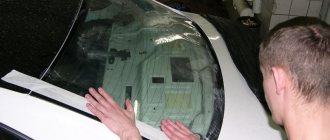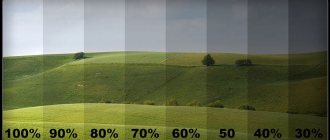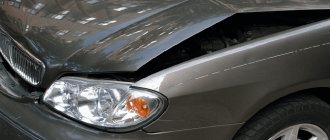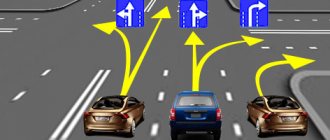Is it possible to remove tint and avoid a fine in 2021?
According to the requirements of the law, the driver is obliged to comply with the legal requirements of the inspector - Part 3 of Article 30 of the Police Law. These are the requirements associated with the collection of evidence in an administrative case. If there are visual signs of a violation (dark glass), then the inspector has the right to demand measurement of their light transmission. Obstruction of measurements - failure to comply with legal requirements with subsequent punishment under Part 1 of Article 19.3 of the Code of Administrative Offenses, up to arrest for 15 days.
Let's trace the chain of legislative acts at the request of the inspector!
- Legal are the demands of traffic police officers that are based not only on their rights and responsibilities, but for which the procedure for exercising rights and responsibilities is determined - part 3 of article 12 and part 3 of article 13 of the Federal Law on Police.
- This procedure is given in paragraph 126 of the regulations, which contains references to paragraphs. 96-99 of the Administrative Regulations for Supervision of the Technical Condition of Vehicles.
- In addition, restriction of the rights and freedoms of citizens is permissible only on the grounds and in the manner established by federal law - Part 2 of Article 6 of the Law “On the Police”.
- The grounds are specified in paragraph 111 of the Administrative Regulations of the State Traffic Safety Inspectorate. We are talking about the presence of signs of an offense under Article 12.5 of the Code of Administrative Offences.
- According to the listed standards, the inspector’s demands to provide a car to measure light transmission are considered legal. And, if the driver, instead of fulfilling a legal requirement, rips off the film, then he is sent to a judge, who makes a decision on punishment under Part 1 of Article 19.3 of the Code of Administrative Offenses.
According to the listed standards, the inspector’s demands to provide a vehicle for measuring light transmission are legal. And, if the driver, instead of fulfilling a legal requirement, rips off the film, then he is quite rightly sent to a judge, who makes a decision on punishment under Part 1 of Article 19.3 of the Code of Administrative Offenses. True, not every removal of film will result in punishment.
When is it not necessary to remove film at all?
Requirements for the light transmittance of rear windows, relevant for 2021, are established in clause 4.3 of the Technical Regulations “On the Safety of Wheeled Vehicles”. And the rear windows can be covered with film without any restrictions. The only requirement is the presence of side rear view mirrors on the right and left.
Front windows must have a light transmittance of 75%, as specified in UN Regulation No. 43. Otherwise means making changes to the design, with subsequent possible termination of vehicle registration. However, in the mentioned paragraph 4.3 of the regulations, a reduction in light transmission of up to 70% is allowed, apparently due to the natural wear of the glass.
If you plan to use the car as a living room in case you are kicked out of the house, and it is constantly parked and does not go on the road, then you can paint over all the windows with black paint. The percentage of light transmission is important only when driving a car, which begins the moment it starts moving.
Thus, tinting is not prohibited in principle, but there are 2 conditions:
- or your car is stationary, and then you can at least board up all the windows with plywood,
- you drive a car, then the tinting together with the glass must transmit at least 70% of the light, otherwise such film must be torn off by law.
You will also be interested in:
- Who is responsible for the car if the driver is picked up by traffic police officers and taken away?
- All about the new warning in the police in questions and answers
- Does a traffic police officer have the right to stop and check the documents of pedestrians and passengers?
Do I need to remove the tint on site?
Readings taken in any other weather conditions are considered illegal, even if they give the correct result or as close as possible to it. At the same time, any violations of this kind on the part of the inspectorate are not a reason for rudeness towards the inspector.
Polite, correct treatment without raising your voice or adding a bright emotional color to your speech is the only right decision when conducting a dialogue with traffic police officers.
At the same time, you need to confidently indicate your knowledge of the current legislation, committing to pay a fine if it has a fair justification, and remove the tint within 10 days, because this is the period given to eliminate the violation.
Unfortunately, practice shows that sometimes not only motorists, but also law enforcement officers “float” in the laws. That is why the only way to protect yourself is not to neglect studying the law and all amendments made to it.
We removed the tint before measuring - what happens?
Let's return to our case when the driver removed the tint before measuring its dose of transmitted light. As already mentioned, this threatens the driver with a fine or arrest for up to 15 days under Part 1 of Article 19.3 of the Administrative Code. But everything is not as simple as it seems to police and judges.
As stated, in order to limit the rights and freedoms of a citizen, the federal law must specify the procedure for restriction. For the Code of Administrative Offences, this is Section IV of the Code.
For example, according to the Code of Administrative Offences, to establish the event of driving a vehicle while intoxicated, a protocol of removal from driving a vehicle, an examination report, a protocol of referral for a medical examination are drawn up, and certified by witnesses.
There is nothing similar in the Code of Administrative Offenses to establish the event of an offense related to the technical condition of the car, including those related to tinting.
To be fair, there is no point in focusing particular attention on a trivial omission in the legislation, since all traffic police vehicles are equipped with devices for measuring light transmission, and the loss of drivers’ time on measurements is minimal.
But the situation changes when the device turns out to be faulty or the inspector does not have the device with him. The traffic police officer leaves to look for the device, at the same time smoke, eat, chat, make a call, breathe... And the driver is ordered to wait and not rock the boat. This action in the Code of Administrative Offenses is called detention, which is properly formalized. No registration – the detention is illegal.
Against the background of an illegal detention, the lack of order defined by federal law when measuring light transmission takes on a completely different shade, emphasizing the ignorance of the inspector - one can still agree with a slight violation of the law, but lawlessness is already too much.
Brief information: detention is legal when it takes place:
- base,
- target
- and the motive for the arrest.
If the inspector goes to look for the device, then the motive for the arrest is replaced by the goal - collecting evidence of an offense, which once again proves the incompetence of the policeman. But this is a topic for another article.
If the detention is illegal, then all subsequent actions of the inspector are also illegal. Therefore, removing tinting cannot in any way contradict the requirements of the law. Moreover, if the driver manages to remove the tinting from all windows.
Can you imagine how long it takes to remove film from all glass by an untrained person without any tools? And where was the inspector at that time?! But according to the standards, only 30 minutes are allotted for a complete technical inspection of a passenger car on the road, including measuring the light transmittance of the windows - clause 99 of the regulations on the supervision of the technical condition of vehicles.
By the way, you can read about the measurement rules in our special article.
Can a traffic police officer seize the film and rummage through the car?
All reasons for searching a car are listed in paragraph 202 of the regulations, which fully complies with the requirements of the Code of Administrative Offenses and the Law on the Police. The torn film is neither an object nor an instrument of a crime, just as it is neither a drug nor ammunition. The same applies to the inspection of things in the possession of an individual.
Therefore, the inspector has no right to seize the film and rummage through the driver’s belongings.
Can an inspector detain or arrest?
Arrest is a type of punishment that can only be imposed by a judge. If the driver faces arrest under Part 1 of Article 19.3 of the Code of Administrative Offenses for disobeying the legal demands of the inspector, then the latter has the right to detain him and take him to the magistrate’s court, if the court is open at that moment.
If it is evening or night, then the inspector must have a motive to detain the driver. In order for a person who has a permanent place of residence and who has never hid from any authorities to be shoved into a “monkey box” before trial, the policeman must have an ironclad motive, clearly and clearly stated in the arrest report.
The driver should immediately declare that he is ready to appear in the magistrate’s court at the first request. At the same time, give the exact address of residence, actual place of work, personal telephone number and telephone number at the place of work. This step will confirm that the driver does not intend to hide from justice.
Thus, the arrest is illegal if you removed the tint before the measurement, and there should not be such a penalty for this under the law.
Methods for removing tint film from a car
Let’s immediately make a reservation that this work can be entrusted to a car service worker . But, if you want to save money and like to tinker with your car, you can remove the window tint yourself . There are four effective ways to remove film:
- By heating the surface with a hair dryer or steam generator.
- Using soapy water.
- Mechanical method.
- Using ammonia.
Removing tint using heat
Thermal removal is applicable in warm weather, such as summer or when work is being done in a heated garage. To remove old tinting from a windshield or side window, you need to prepare a household hair dryer or steam generator . A hair dryer used for construction purposes must be used very carefully, since at too high temperatures there is a high probability that the glass surface may burst or the film will melt and flow across the glass. In this case, it will be much more difficult to remove it.
As practice shows, with a steam generator ; the film not only quickly lags behind the glass, but also the adhesive layer is immediately removed. But when using a steam generator, it is also worth considering safety precautions. This device generates and supplies steam under high pressure; you must work with extreme caution to avoid getting burned. When working with a hairdryer and steam generator, you must ensure that the hot air is not directed for a long time onto the plastic and rubber elements of the interior, which can become deformed under the influence of hot air.
It is more convenient to carry out this procedure with a partner : one heats the surface with a hairdryer, and the other begins to dismantle the film layer.
Procedure for removing film by heating :
- Surface heating . It is necessary to turn on the device and direct warm air onto the film. At a temperature of +40 degrees, the tinting will begin to come off the glass.
- Removing the coating . Use a sharp object, such as a blade, to pry the edge, then carefully pull the material.
- , an adhesive layer remains on the glass surface . The glue is removed with warm soapy water or solvent.
Removing the film with soapy water
In order to properly remove tint , you will need 30-40 ml of any liquid detergent, dissolve it in a liter of warm water. The resulting solution is poured into a sprinkler.
How to remove tint correctly:
- Spray the soap mixture onto the edges of the coating.
- As soon as the edges begin to peel off, continue to spray water onto the inner sticky layer of the film. If the edge does not come off, you can slightly pry it with a blade.
- Slowly and very carefully begin to pull off the film and constantly moisten it with water.
- When the coating is completely removed , begin to remove the adhesive layer . The glass is moistened with the same soapy mixture and the remaining glue is removed with a scraper. If the soap solution is not effective and glue clumps are still present, they can be removed with solvent or acetone.
Automotive stores sell special products for removing tint; using them, you can quickly complete the entire operation.
Removing tint with ammonia
One of the most effective methods of detonation is using an ammonia solution , and this option is even suitable for removing old coating and coating from the rear window, where there are heating filaments.
You will need: ammonia, soap solution, spray bottle, black plastic bags and a respirator .
Work order:
- Spray the soap mixture .
- Wet the surface with ammonia .
- Cover the tint with polyethylene and spray it on top again with ammonia , leave for a while. Under the influence of sunlight and an ammonia solution, the coating will begin to peel away from the glass.
- If the film begins to wrinkle, it can be removed.
The glue is removed with soapy water or any solvent.
Removing film by mechanical action
If the tint coating is not old, you can try to remove it using a blade or a sharp thin knife . After the seals are removed, the edge of the film material is pryed with a blade and at the same time pulled towards itself. These steps must be continued until the film is completely removed. This requires patience; quick actions can cause the film to rupture.
After removing the film coating, glue residues ; they are removed with a soap solution or solvent. There is no need to rub or use force, just moisten a rag in the solvent and leave it on the surface of the glass, after a while the glue will dissolve, and all you have to do is wash the glass and wipe it dry with a soft cloth.
Another way to remove Chinese film without using any tools or equipment. To do this, you need to dismantle the glass , lower it into the bath and pour very hot water. The film itself will come off the glass.
Is it possible to rip off and avoid the requirement?
If the light transmission of the glass does not meet the requirements of the Technical Regulations, then the event of an offense under Part 3.1 of Article 12.5 of the Code of Administrative Offenses is established, and either a protocol is drawn up against the driver or an order is immediately issued.
But the policeman has a question: should a driver with tinted windows be released? After all, he will continue to violate the requirements of the law, and such management in itself is unsafe.
To commit an offense, there must be reasons and conditions. In our case, the reason is the application of a tint film. But window tinting in itself is not an offense. For an offense to take place, the driver only needs to start driving. Starting to move, that is, driving a car, is a condition for an offense.
To eliminate the conditions of the offense, the driver with tinting is issued a so-called “Demand to eliminate the conditions leading to the offense.” In itself, such a requirement is illegal - it replaces a warning. But the practice of punishing for failure to comply with the requirement to terminate management in the courts has become established.
In order to avoid having to issue such a paper to the driver, most often in practice in 2021 it is enough to remove the tint from the windows yourself on the spot.
Something else useful for you:
- Is it legal for a traffic police inspector to demand that he get out of the car?
- Requirement for tinting: how to remove it and is it legal?
- Suspension from driving a vehicle in questions and answers
Removing tint film from headlights
remove the film layer from headlights yourself using the same methods as from windows. If the tinting layer was applied using paints and varnishes, the algorithm of actions is somewhat different. The surface of the headlights needs to be sanded. To do this, use a grinding machine or sandpaper with an abrasive layer, first 2000, then 3000. The headlights are sanded until the tint is completely removed. Before starting work, you need to tape the joints of the headlights and adjacent surfaces with masking tape.
After reading the instructions and useful tips, you can choose the appropriate tint removal option for yourself. The main thing is to prepare the necessary tools and means in advance, be patient and carefully complete all the work.
There is also a video on how to properly remove tint.
The policeman demands to eliminate it in front of him - do I have an obligation?
Drivers have a responsibility to comply with legal requirements. These are not only traffic rules, but also the requirements of the Technical Regulations, which set standards for the light transmission of glass.
The driver's reaction time ranges from 0.3 to 1.8 seconds depending on the situation, the driver's condition and other factors. In the dark on unlit roads, the reaction time increases by 0.6-0.7 seconds. For this reason, driving at a speed of 90 km/h at night with low beam headlights is unsafe.
Tinting with light transmission less than 35% increases reaction time by 0.1-0.7 seconds. That is, it is already unsafe to drive a tinted car at high speeds during the day. Driving a tinted car at night is borderline suicidal.
For some time, the driver is saved by excellent knowledge of the road, which reduces reaction time. But one day an unfamiliar object appears in the headlights, its outlines fall on the retina of the eyes, the information goes to the brain, and it begins to recognize. After all, he first needs to decide: is there a danger or not?
The brain solves the problem, time passes, and the driver drives towards an obstacle with the instinct of self-preservation completely turned off.
This is the situation that the requirements of technical regulations prevent. And if a policeman demands that the tint be removed on the spot, then it is better to meet him halfway.
However, there is an alternative option. Driving ends when the need to move is exhausted. This situation occurs if the driver calls a tow truck.











